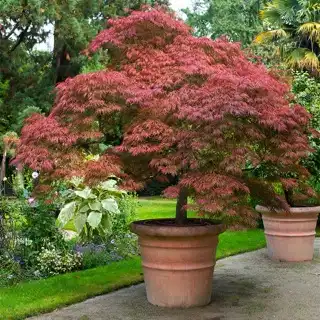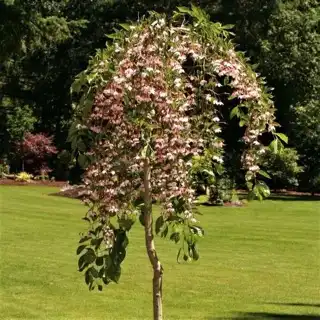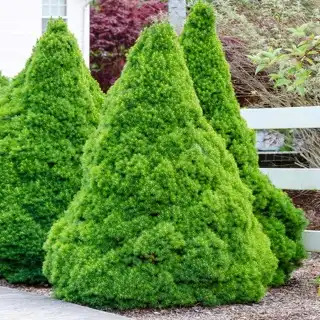Not every tree is the same. When seeking a compact and low-maintenance choice, individuals desire a tree that can be appreciated every single day.
In landscaping, trees are chosen for a specific reason. Whether you want a tree to stand alone, create a privacy border, provide food, or dramatize an entrance, there are many varieties to choose from.
In addition to being the perfect fit for your landscape, being moderately sized, and being easy to take care of, we also want something eye-catching.
The trees listed below are just that – unique showstoppers that are sure to satisfy.
1. Dwarf Japanese Maple

- Mature Height: 3 to 6 feet
- Grow Zones: 5 to 8
- Popular Varieties: Shishigashira, Fairy Hair, Kurenai Jishi, Mikawa Yatsubusa
The Dwarf Japanese Maple is perfect for smaller spaces and containers. They grow wider than tall and into a balanced, round shape.
The foliage changes color seasonally, and the branches are attractive even after the bright leaves drop in autumn. Dwarf maples grow slowly and require little maintenance.
Plant in moist, well-drained soil in a partially shaded area with dappled sunlight. Watering once or twice a week once established is sufficient.
2. Weeping Japanese Maple

- Mature Height: 8 to 10 feet
- Grow Zones: 5 to 8
- Popular Varieties: Orangeola, Ryusen, Firefall Weeping Red, Emerald Leaf Weeping Green, Red Dragon Weeping Lace
The weeping varieties of Japanese Maple are beautiful year round. The branches and leaves cascade down in an umbrella shape and have stunning foliage that changes color each season.
Different types boast leaves that change to purple, red, orange, pink, and yellow.
These are hardy, slow-growing trees that like partial shade or dappled sunlight. Some varieties, like the Viridis, can handle full sun if the climate is cool.
3. Rose of Sharon

- Mature Height: 8 to 10 feet
- Grow Zones: 5 to 9
- Popular Varieties: Blue Chiffon, Ardens Rose, Sugartip, Minerva, Aphrodite
Part of the hibiscus family, rose of Sharon is a bush or small tree that produces gorgeous trumpet-shaped flowers. Blooms are large and come in white, lavender, and purple.
Tolerant to many soil conditions, rose of Sharon can also handle drought, though it prefers ample moisture. This tree is also happiest in full sun to partial shade.
Pruning is not necessary if you want a shrub-shaped plant. However, it can be easily cut back on occasion to take the form of a tree with multiple small trunks.
4. Sargent Crabapple

- Mature Height: 6 to 10 feet
- Grow Zones: 4 to 8
- Popular Varieties: Tina, Firebird, Rose Glow, Candymint
An eye-catching tree that produces fragrant, delicate white blooms, the Sargent crabapple is ideal for smaller spaces because of its height at maturity.
It can spread up to 12 feet wide, so give it a little room when planting. It prefers full sun and is an alternate bearer, meaning it produces blooms every other year.
The tiny fruit is attractive to many varieties of songbirds. Trees are dense and grow naturally into a rounded shape.
5. Dwarf Italian Cypress

- Mature Height: 7 to 9 feet
- Grow Zones: 8 to 10
- Popular Varieties: Totem, Tiny Tower
The Dwarf Italian Cypress naturally grows in a narrow column shape perfect for hedges, borders, containers, or to create privacy in the landscape.
It is an evergreen and has fragrant, dark, dense, greenish-blue foliage. It likes full sun, is deer resistant, and is drought tolerant. It is a slow-growing tree that takes many years to reach maturity.
6. Semi-Dwarf Crape Myrtle
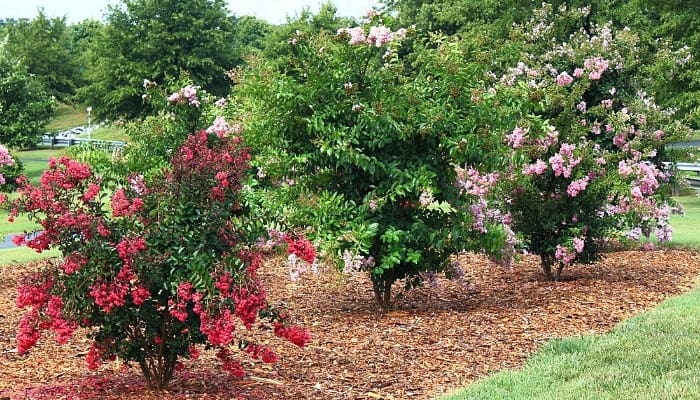
- Mature Height: 5 to 10 feet
- Grow Zones: 6 to 10
- Popular Varieties: Pink Hopi, Purple Zuni, Red Ebony Flame, Red Tonto, Siren Red
Crape myrtles will bring joy to your yard with their pink, purple, red, or white blooms that grow all summer long.
Bright flowers grow in giant clusters that coax butterflies and hummingbirds to come hang around.
Grown as shrubs or pruned into trees, these are great to plant in groups along edges or on their own as ornamental pieces.
When young, these are fast-growing trees and easily grow an additional 3 to 5 feet each year.
7. Sand Cherry Tree

- Mature Height: 7 to 10 feet
- Grow Zones: 3 to 7
- Popular Varieties: Purpleleaf, Pawnee Buttes, Western, Dwarf Red Leaf
The sand cherry tree is a winter-hardy flowering tree that produces fragrant blooms in the spring and small tart cherries that can be used to make jams and jellies.
Sand cherry trees grow quickly and can increase in height from 13 inches to 24 inches each year. Many birds and even coyotes enjoy the fruit as one of their food sources.
The sand cherry prefers full sun to partial shade and needs regular water.
8. Golden Fernspray Hinoki Cypress
- Mature Height: 8 to 10 feet
- Grow Zones: 4 to 8
- Popular Varieties: Dwarf Hinoki Cypress, Jade Waves Fernspray False, Gold Mop, Fernspray Gold False Cypress
Golden Fernspray will add a fresh twist to your evergreen landscape. The foliage is reminiscent of fern branches and is flat and feathery.
It has a lemon-green color with golden yellow tips. This is a slow-growing tree that will only increase in height by about 6 to 8 inches a year.
It grows upright in a pyramid shape and will be about half of its height in width. This low-maintenance tree likes partial shade to full sun and average water. It is resistant to deer.
9. American Snowbell Tree
- Mature Height: 6 to 9 feet
- Grow Zones: 6 to 8
- Popular Varieties: Evening Light, Baby Blue, Carolina Snowbell
A unique shrub, the American snowbell boasts small, aromatic, bell-shaped flowers that hang from branches in late spring to early summer.
Native to swamps, these trees prefer moist and damp conditions. They do the best in partial sun and shady areas.
Snowbells are therefore great for use around ponds, fountains, or other water features in your yard.
Beneficial insects, bees, and other pollinators are attracted to snowbells. Birds will nest in and use the trees for cover.
10. Weeping Redbud

- Mature Height: 6 to 8 feet
- Grow Zones: 5 to 9
- Popular Varieties: Lavender Twist, Ruby Falls, Flame Thrower, Cascading Hearts, Carolina Sweetheart
The weeping redbud has lavender-pink, red, or burgundy colored blossoms that burst open in early spring. The large, heart-shaped leaves and blooms cascade downward like a waterfall.
In the fall, the leaves turn yellow and then drop, leaving interesting twisted branches over the winter.
These trees need full to partial shade and like moist, well-drained soil and regular water. They are ideal to fill a smaller space and make an interesting statement in your landscape.
Blooms attract bees, hummingbirds, and butterflies.
11. Highbush Cranberry

- Mature Height: 8 to 15 feet
- Grow Zones: 2 to 7
- Popular Varieties: Wentworth, Andrews, Hahs
Though the fruit of the highbush cranberry does resemble the fruit, it is actually not a true cranberry and, instead, is part of the honeysuckle family.
If planted close, 2 to 3 feet apart, the shrub is ideal for creating a privacy wall. A low-maintenance tree, it likes full sun to partial shade and well-drained, moist soil, and it is drought and frost tolerant.
The self-pollinating tree produces large white blooms surrounding smaller white blooms. After five years of growth, trees begin producing fruit, which can be substituted for cranberries.
12. Dwarf Peach

- Mature Height: 8 to 10 feet
- Grow Zones: 5 to 9
- Popular Varieties: Elberta, Red Haven, Bonanza, Reliance, Orange Cling, Halloween
Though dwarf peaches are much smaller in size than their regular fruit tree counterparts, they still yield average size peaches.
The trees are also obviously more petite, making them easier to maintain. The smaller varieties will also produce fruit sooner, a year or two earlier than a traditional peach tree.
Partial to full sun, dwarf peaches like sandy, well-drained soil and are not drought tolerant. These trees bloom in the spring and produce fruit in mid to late summer.
13. Dwarf Plum

- Mature Height: 8 to 10 feet
- Grow Zones: 4 to 9
- Popular Varieties: Burbank, Johnson, Santa Rosa, Black Ice
Dwarf fruit trees are ideal for small spaces as you can harvest regular-sized fruit without having to have an entire orchard or large area for a tree to mature.
Japanese and European are the two most common types of plums. European plums can handle slightly cooler climates.
Trees can be grown in containers and moved inside in winter climates when the temperature drops.
Dwarf plum trees also need lots of sun and well-drained soil but are generally low maintenance.
Most plum trees are not self-pollinating, so you will need to plant more than one tree for them to yield fruit.
14. Dwarf Cherry

- Mature Height: 5 to 8 feet
- Grow Zones: 2 to 7
- Popular Varieties: Black Tartarian, Juliet, Romeo, Dwarf Bing, Carmine Jewel
The dwarf cherry was designed to be more cold tolerant, so you will commonly find them in cooler climates. They produce fruit and grow quickly, making them better for shorter growing seasons.
They prefer well-drained soil and a sunny location. The cherries are still an average size despite the size of the tree, and pending on the variety, they can taste either tart or sweet.
15. Dwarf Apple
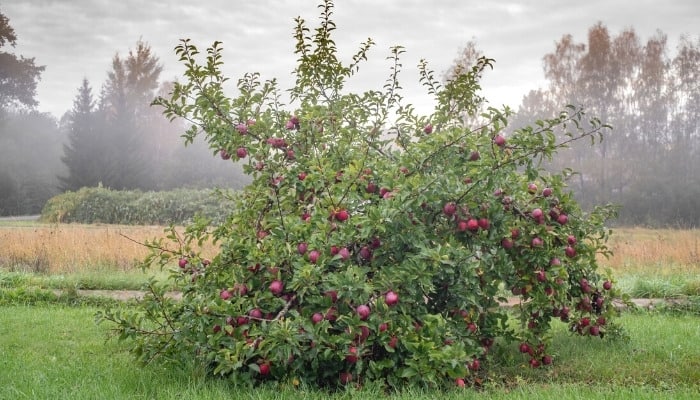
- Mature Height: 8 to 10 feet
- Grow Zones: 3 to 6
- Popular Varieties: Cameron Select, Goldrush Dwarf, Gala Dwarf, Arkansas Black, Fuji Dwarf
Apple trees produce small, pretty white blooms in the spring and summer and yield fruit around September.
Dwarf apple trees can produce fruit as early as three years after planting, whereas standard apple trees may take up to 10 years for you to see any fruit.
Many apple trees are susceptible to insects and diseases. When choosing a variety, be sure to decide which resistance is essential for your location.
16. Dwarf Fig

- Mature Height: up to 15 feet unless pruned
- Grow Zones: 8 to 10
- Popular Varieties: Little Miss Figgy, Black Jack, Brown Turkey, Celeste, Desert King, Neveralla
These drought-tolerant trees prefer full sun and are self-pollinating, which means they can stand alone. In addition, they like well-drained soil that is not acidic.
Fig trees have large leaves and look somewhat tropical. The trees will become just about as wide as they are tall.
They often yield fruit twice a year – one small crop in early summer and a larger harvest in late summer to early fall.
17. Dwarf Citrus

- Mature Height: 8 to 12 feet
- Grow Zones: 8 to 10
- Popular Varieties: Meyer lemon, tangerine, kumquat, clementine, Owari Satsuma
Dwarf citrus trees are the perfect solution to having fresh fruit without giant space. You can grow these trees in containers on your patio, yard, and even inside if you live in a colder climate.
Citrus trees need lots of sun and well-drained soil. A nitrogen fertilizer every so often is crucial.
Citrus is temperamental to change, so be sure they are located in an area where the temperature stays between 55 and 85 degrees Fahrenheit year round.
18. Goldcrest Cypress

- Mature Height: 6 to 10 feet
- Grow Zones: 7 to 10
- Popular Varieties: Wilma Goldcrest, Goldcrest Lemon
This evergreen grows in a slender vertical column shape and is a bright yellow color year round. The foliage has an aromatic smell of lemon.
This is a low-maintenance conifer that needs little water and is salt tolerant. These trees like full sun to partial shade and well-drained soil.
Goldcrest Cypress can be grown in containers if watered regularly. They are also a fantastic choice for borders around a patio, camouflaging a fence, or bordering a driveway.
19. Dwarf Alberta Spruce

- Mature Height: 3 to 12 feet
- Grow Zones: 5 to 7
- Popular Varieties: Dwarf Alberta spruce, dwarf white spruce
Dwarf Alberta spruce is an evergreen with dense, light green foliage that grows upward in a pyramid shape. They are intolerant of salt and warm weather and do best in cooler climates.
Alberta Spruce do, however, prefer full sun to partial shade. You can grow these in containers, along hedges, and in planters.
They make an ideal Christmas tree but can also be pruned into shapes for a fun twist. They have a beautiful evergreen fragrance.
20. Pygmy Date Palm

- Mature Height: 6.5 feet outside, 4 to 5 feet inside
- Grow Zones: 10 to 11
- Popular Varieties: Pygmy date palm
The Pygmy date palm has a traditional palm tree look but in a smaller form. They are perfect for getting that tropical feel inside in cooler climates, or you can grow them naturally outside in warmer areas.
These trees can grow up to 5 feet wide. They prefer partial shade to full sun and like humidity.
They produce cream-colored, star-shaped flowers in the spring and yield edible fruit called drupes in the spring and summer.
Decisions
Looking for something pretty to plant along the street that also provides privacy? Go for a dwarf Japanese maple.
If you’re dying for a citrus tree but don’t live where it snows, place a potted dwarf Meyer lemon tree inside in a sunny window.
Try a sand cherry tree if you want a heavenly scent to fill your nose when walking through the yard.
Whatever you are trying to achieve, there is a tree for you. Happy planting!


